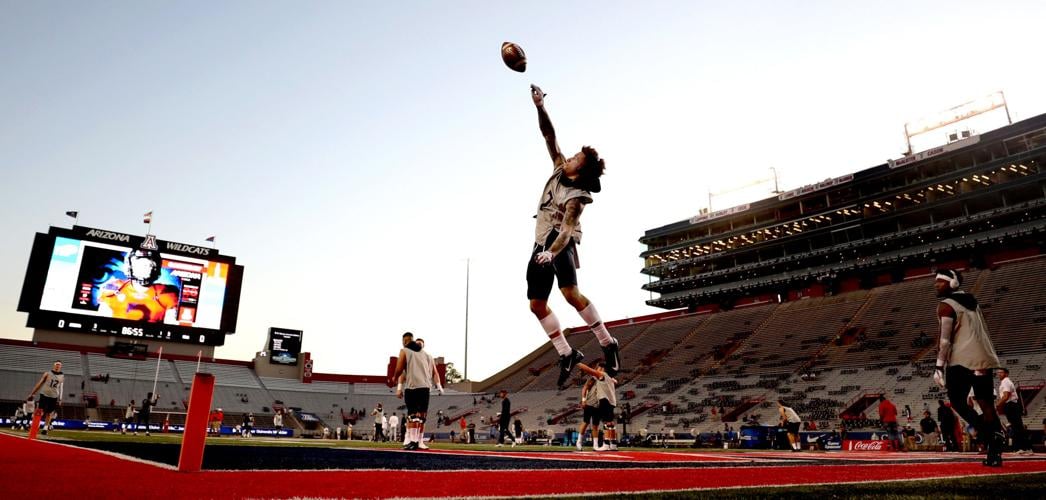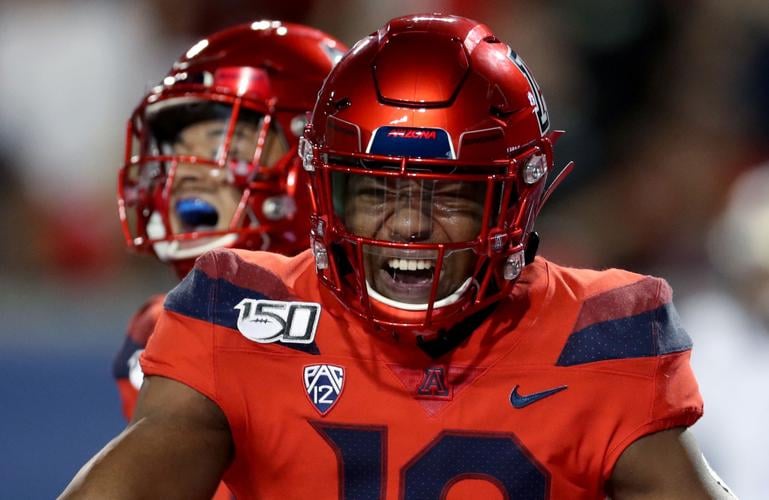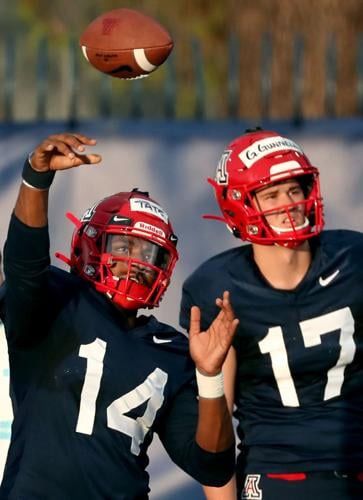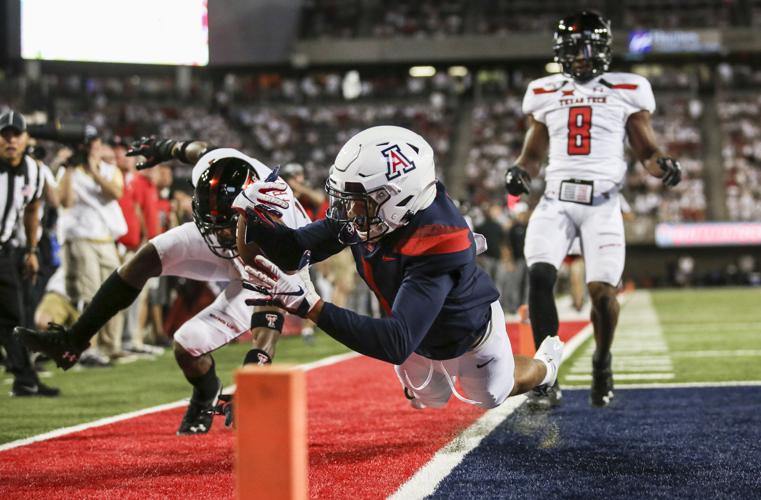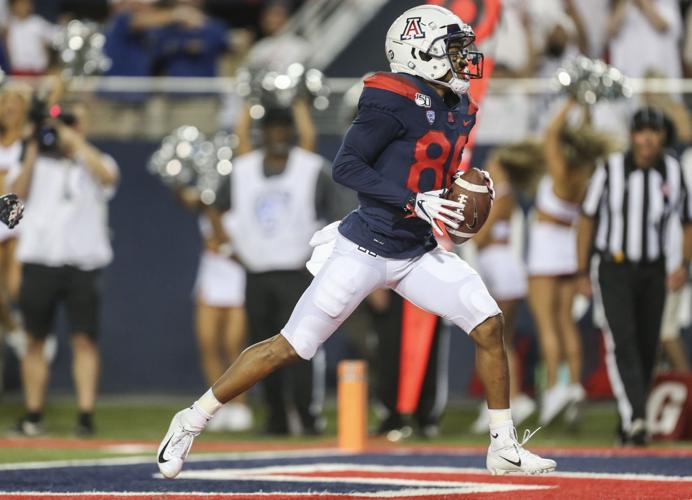Arizona Wildcats WR Jamarye Joiner makes a one-handed TD catch — and a dream come true

Arizona wide receiver Jamarye Joiner (10) celebrates after scoring in the second quarter against Washington at Arizona Stadium on Oct. 12, 2019.
Like countless other kids, Jamarye Joiner dreamed of making the “SportsCenter” Top 10 one day. Then it happened.
The Arizona Wildcats receiver made a gorgeous one-handed catch for a touchdown against Stanford last week. It came in at No. 5 on ESPN’s signature highlight show.
“It was mind-blowing,” Joiner said this week amid preparations for Arizona’s homecoming game against Oregon State on Saturday.
It was the latest example of Joiner’s seemingly limitless potential. The Cienega High School product shifted from quarterback to wideout in the offseason. As expected, he has experienced a few hiccups while making the transition. But he ranks third on the team in catches (21), second in receiving yards (315) and tied for first in touchdown receptions (three).
Not bad for a guy who made the move just a few months ago.
“He’s had flashes,” UA coach Kevin Sumlin said. “He’s done some really, really good things. He’s dropped some balls. He’s run some really great routes. He’s run some bad ones.
“You would think that with his talent level, his size and (if he keeps) working at it, the sky’s the limit for the guy. He’s just now getting going.”
Joiner spent his first season at Arizona at quarterback, briefly appearing in two games. He approached Sumlin and offensive coordinator Noel Mazzone after spring practice about switching to receiver, knowing he’d have a better chance to get on the field and contribute to the team.
Joiner immediately made an impact, catching four passes for 72 yards and a touchdown in the opener at Hawaii. He matched his career high with four receptions at Colorado. He caught three balls for 55 yards, including a career-long 40-yard touchdown, against Washington.
Joiner also lost a fumble at a critical moment in that game. The following week, at USC, he dropped a would-be touchdown pass on a ball that was much easier to catch than the one-hander at Stanford.
In moments like those, Joiner leans on his past. He developed a short-term memory when he was the one throwing the ball.
“That’s just the quarterback in me,” Joiner said.
“It happens. You can’t change it. So move on.”
Joiner capitalized on his next opportunity to catch a pass in the end zone.
Arizona faced first-and-10 at the Stanford 18-yard line late in the second quarter. Joiner lined up in the slot to the right. Khalil Tate faked a bubble screen to Brian Casteel, who had motioned to that side. Joiner stutter-stepped, then raced toward the right pylon. He got outside leverage on Cardinal defensive back Malik Antoine.
“I almost didn’t get the right signal,” Joiner said. “I looked over at the last second. I saw the signal. I lined up. I had to widen my split a little bit. I ran the route. The line blocked perfectly. Khalil threw it. The defender, he had good position on me. So I threw my hand up and it stuck to my glove.”
Antoine lunged into the left side of Joiner’s body just before the ball arrived. His only option was to reach for the ball with his right hand.
One-handed catches aren’t nearly as uncommon as they used to be. Odell Beckham Jr. made them regularly with the New York Giants, and young receivers have been copying him ever since.
It isn’t unusual to see receivers practice one-handed grabs. Joiner doesn’t do it often. What happened at Stanford — his SC Top-10 moment — was pure instinct.
“It’s something that just happens in the moment,” Joiner said. “You can’t practice things like that.”
‘I trust them both fully’: Wildcats embrace two-quarterback system

University of Arizona's Khalil Tate throws a pass in front of Grant Gunnell as the quarterbacks throw to receivers during drills on day 6 of their pre-season, Tucson, Ariz., August 1, 2019.
One of the reasons Arizona’s quarterback rotation just might work is that the two players involved in it are so different.
Senior Khalil Tate, when healthy, is a true dual threat. He’s a playmaker.
Freshman Grant Gunnell is a distributor. The quicker he can get the ball out of his hand, the better.
The Wildcats used both quarterbacks against Stanford last week, and the plan is to do so again against Oregon State. The Beavers will have to prepare for both players and adjust accordingly when Gunnell comes in for Tate, assuming that remains the order.
Arizona’s other offensive players say that little, if anything, changes when the team changes quarterbacks.
Here’s what four players — two wide receivers and two offensive linemen — had to say about adjusting to in-game quarterback changes:
Receiver Jamarye Joiner: “It’s just run your route and do your job. All I can do is make the best decisions for myself. If I do my job, then I’m … making their job easier.”
(Note: Joiner used to be part of a two-quarterback system — in Pop Warner.)
Receiver Drew Dixon: “They both bring different things to the table. But I trust them both fully.”
Guard Robert Congel: “Both of them are so talented in different aspects of the game. Khalil, he’ll scramble more. Grant will stick in that pocket. Khalil can make plays with his feet, and Grant can throw the ball. So we really have two good options. We spend so much time with them in practice that, once you see (either of) them behind you in the game, it’s not a huge deal.”
Tackle Paiton Fears: “It’s the same. My focus is to protect them, both of them, whoever’s in. … You’ve gotta be aware of which quarterback is in, of course. But I just try to focus on doing my job, whether it’s Khalil or Grant.”
Return of J.J. Taylor, reshuffling of O-line have UA ground game rolling again

Arizona running back J.J. Taylor squirts through a gap in the Northern Arizona line on his way to the end zone during the first quarter of their football game at Arizona Stadium, Tucson, on Sept. 7, 2019.
Arizona’s new offensive linemen are learning what it’s like to block for J.J. Taylor.
Sometimes, it can be an adventure. Most of the time, it’s a delight.
Taylor, a man of many moves, has averaged 92 rushing yards over the past three games. Back from an ankle injury that kept him out of most of the previous three contests, Taylor has displayed his full arsenal of cuts, jukes and spins.
“There’ll be some times you think the play is dead,” guard Robert Congel said. “Once at Stanford, it was looking like the play was dead. Then I see J.J. make about seven different cuts and take it. He is unbelievable.”
Taylor rushed for a season-high 107 yards on 16 carries last week against the Cardinal. It was his first 100-yard game since Sept. 7 against NAU.
“It’s fun,” tackle Paiton Fears said. “He’s so explosive. I love blocking for him. As long as we do our job, he’s gonna make big plays.”
Congel and Fears weren’t part of Taylor’s historic performance the last time Arizona faced Oregon State. Taylor rushed for 284 yards, the fourth-highest total in UA annals. Arizona gained 442 yards on the ground in a 35-14 victory in Corvallis last September.
Congel was a member of the team but had to sit out because of NCAA transfer rules. Fears was playing for Hutchinson Community College in Kansas.
They do know what it’s like to open holes for a prolific rushing attack, though. Despite a midseason slump, Arizona is averaging 202 yards per game, second-most in the Pac-12.
The Wildcats’ 222 yards at Stanford were their most since a 314-yard output against Texas Tech on Sept. 14. Arizona found a line combination that worked, reinserting Congel into the starting lineup and moving Fears back to tackle.
Congel sat out the Washington game because of a lower-body injury suffered vs. Colorado and shared time at left guard with Fears against USC. Fears, who never had played guard before, returned to his platoon role with Edgar Burrola at right tackle. Bryson Cain filled in at right guard for the injured Cody Creason, who also is expected to miss the OSU game.
The line’s pass protection was sounder, and its run blocking resembled what it had displayed earlier in the season.
“Stanford was a good confidence builder for us,” Congel said. “We’ve just gotta keep it going.”
Arizona WR Drew Dixon shows he’s ready to shoulder more responsibility

Arizona Wildcats wide receiver Drew Dixon (1) reaches for the ballin the end zone during a game at Arizona Stadium Saturday, Sept. 14, 2019. The pass was incomplete.
Could Drew Dixon have made the play a year ago? Perhaps.
But the knowledge and experience he has gained since made it a sure thing.
Dixon scored his second touchdown of the season in Arizona’s loss at Stanford last week. It required a level of sophistication he might have lacked last season.
The redshirt sophomore, who didn’t play receiver full time until he came to the UA, was lined up one on one with star Cardinal cornerback Paulsen Adebo at the 9-yard line in the third quarter. The way Adebo played Dixon would dictate the route he would run.
“He was … just trying to stay on top of me,” Dixon said. “So I was like, ‘All right, it’s going to be a back shoulder.’ ”
With Adebo playing Dixon straight up and preventing him from getting to the back corner of the end zone, the UA receiver knew where the ball should go. Quarterback Khalil Tate recognized the leverage as well and threw it slightly behind Dixon, who disengaged from Paulsen and snagged it just inside the right sideline.
Had Paulsen played Dixon to the inside, he would have run to the corner for a fade.
“It’s something that we practice,” said Dixon, who has 13 catches for 137 yards in his first extended action as a Wildcat. “I know he can either throw it up or throw it on my back shoulder. I just made sure that I was in good position. The ball was right there. Just caught it and executed.”
Dixon makes it sound simple. But he and Tate had to recognize the coverage, and the timing had to be just right. Countless offseason reps paid off in that moment.
“It’s just something that’s in our reads, Dixon said. “It’s just part of our offense. So you’ve got to know how to do that.”
Twice as many Wildcats have caught TD passes this year than last

Arizona Wildcats wide receiver Stanley Berryhill III (86) runs through the endzone after catching a pass by Arizona Wildcats quarterback Khalil Tate (14) to score the first touchdown for the Wildcats against the Texas Tech Red Raiders during a game at Arizona Stadium Saturday, Sept. 14, 2019.
Whether it’s Khalil Tate or Grant Gunnell at quarterback, more Arizona Wildcats are catching touchdown passes than last season — double the amount, to be exact.
Exactly 10 players have TD receptions through eight games, tied with Oregon for most in the Pac-12. Last season, five players hoarded the touchdowns. The disparity is a reflection of Arizona’s commitment to rotating at receiver this season after losing its veteran corps, led by Shawn Poindexter and Shun Brown, to graduation.
Here’s how this year’s 19 passing TDs have spread out:
- WR Stanley Berryhill III, 3
- WR Brian Casteel, 3
- WR Jamarye Joiner, 3
- WR Tayvian Cunningham, 2
- WR Drew Dixon, 2
- RB Bam Smith, 2
- WR Jalen Johnson, 1
- WR Cedric Peterson, 1
- WR Thomas Reid III, 1
- TE Bryce Wolma, 1
And here’s how last year’s 29 were divvied up:
- WR Shawn Poindexter, 11
- WR Shun Brown, 6
- WR Tony Ellison, 6
- WR Cedric Peterson, 4
- WR Stanley Berryhill III, 2


